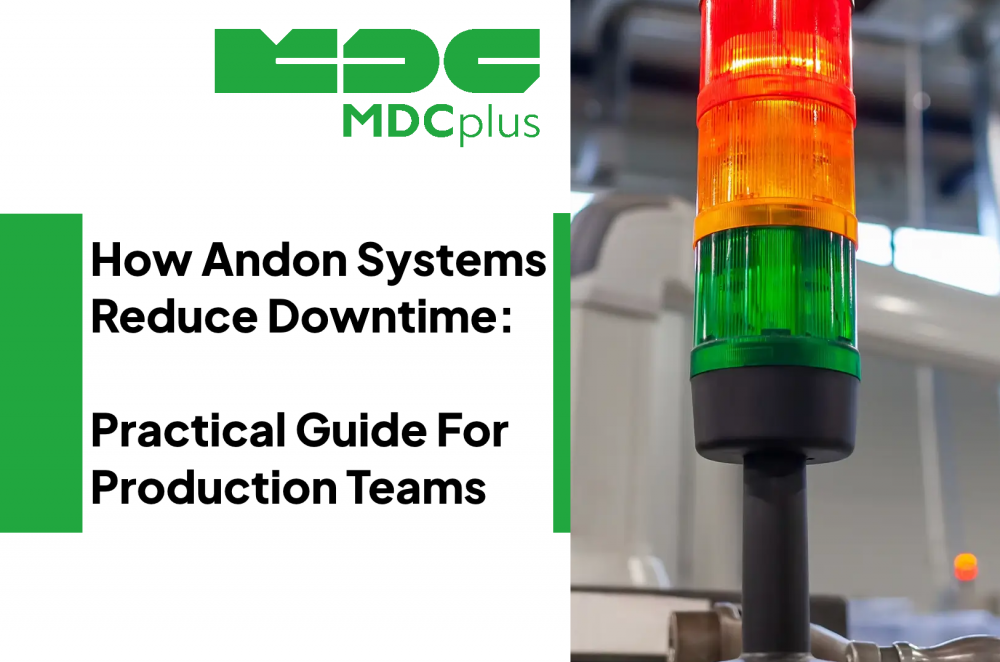How Andon Systems Reduce Downtime: A Practical Guide for Production Teams
Andon systems are real-time visual and audible alerts that signal when equipment stops, quality drops or operators need support. Plants use Andon to cut response time and shorten downtime events.
What an Andon system is and why it matters
An Andon system is a visual alert method used in lean manufacturing to signal a problem as soon as it happens. Typical forms include tower lights, screen alerts, mobile notifications or pull-cords that operators trigger.
The purpose is simple: reduce the time between when a problem appears and when the right person responds.
Factories use Andon because slow awareness leads directly to long downtime. When maintenance sees the issue later than the operator, minutes turn into hours.
How Andon systems reduce mean downtime duration
This is the core question people search: Can Andon actually reduce downtime?
Yes. Andon reduces mean downtime duration by cutting the detection to response interval. Immediate alerts send the problem to the right team without waiting for manual escalation.
The biggest gains come from:
- Faster acknowledgment of equipment stops
- Immediate notification of micro stops that normally go unreported
- Reduced walking time for operators
- Better prioritization for maintenance teams
- Clear visibility of chronic stops and patterns
Plants that implement digital Andon or integrated alerting often report a 15 to 35 percent reduction in downtime duration during the first months.
Where Andon fits inside lean manufacturing
Andon is one of the classic lean tools focused on transparency and rapid action. It ties directly into:
- Jidoka (automation with a human guarantee)
- Standard work
- Waste elimination
- Continuous improvement cycles
- Real-time decision making
Andon does not solve the root cause. It exposes it faster so you can solve it sooner.
How digital Andon improves on traditional light-based systems
Modern Andon systems integrate with machine monitoring tools, PLCs, CNCs and mobile apps. That means:
- Automatic triggers when a machine stops
- Mobile pop-ups for maintenance teams
- Large screen dashboards showing current status
- Timestamped event logs for root-cause analysis
- Escalation rules when nobody responds in time
Engineers prefer digital Andon because it produces data, not just lights. Data makes patterns visible: which machine stops most often, which shift responds fastest, which operator triggers most calls, and which issues cause long delays.
How to implement an Andon system step by step
Search intent around Andon often includes how to implement Andon or how to set up Andon alerts.
Here is the simple and proven sequence:
Step 1: Identify the events that should trigger Andon
Typical triggers include machine stop, tool breakage, quality failure, blocked flow, missing material or operator support.
Step 2: Define clear response roles
Decide who responds to what: maintenance, quality, team lead or supervisor.
Step 3: Choose the alerting method
Options include tower lights, buttons, pull cords, HMIs, or automatic triggers from machine monitoring systems.
Step 4: Set escalation rules
For example:
If no one acknowledges in 2 minutes, alert team lead
If unresolved in 10 minutes, escalate to maintenance
If unresolved in 20 minutes, send to engineering
Step 5: Train operators and standardize reactions
Operators must know when to trigger Andon and what happens afterward. Supervisors must confirm they respond fast.
Step 6: Use Andon data for continuous improvement
Review logs weekly to find the longest downtime events, recurring issues and slowest responses.
Common mistakes when using Andon systems
- Too many triggers that overload the team
- No assigned responsibility for each alert
- Slow response to alerts that trains operators not to use the system
- Lack of follow-up analysis
- Treating Andon as a punishment tool instead of a support tool
Andon only works when responses are fast, clear and consistent.
Summary
Andon systems help production teams reduce downtime by making every problem visible in real time. Whether you use tower lights or digital dashboards, the goal is the same: fast reaction, quick support and better flow. Plants that adopt Andon correctly see measurable improvements in uptime and team communication.
FAQ
Q: Can Andon work without machine monitoring?
A: Yes. You can start with manual pull cords or buttons, but automatic triggers improve accuracy and data quality.
Q: How fast should teams respond to an Andon alert?
A: Many plants define a target acknowledgment time of under 2 minutes and a full response target under 10 minutes.
Q: Do digital Andon systems require expensive hardware?
A: Not necessarily. Many setups use existing HMIs, tablets, signal towers and standard network infrastructure.
About MDCplus
Our key features are real-time machine monitoring for swift issue resolution, power consumption tracking to promote sustainability, computerized maintenance management to reduce downtime, and vibration diagnostics for predictive maintenance. MDCplus's solutions are tailored for diverse industries, including aerospace, automotive, precision machining, and heavy industry. By delivering actionable insights and fostering seamless integration, we empower manufacturers to boost Overall Equipment Effectiveness (OEE), reduce operational costs, and achieve sustainable growth along with future planning.
Ready to increase your OEE, get clearer vision of your shop floor, and predict sustainably?
